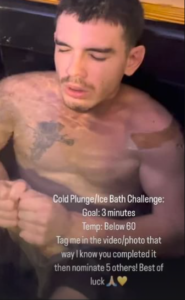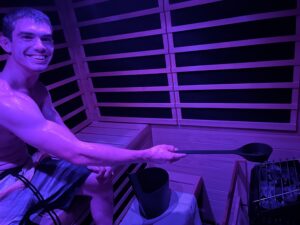“Wellness encompasses a healthy body, a sound mind, and a tranquil spirit. Enjoy the journey as you strive for wellness.” – Laurette Gagnon Beaulieu
In the madness of life, we find ourselves struggling to find the balance between an underwhelming daily to-do list, stressing about having money until the next paycheck, and finding the time for family, friends, and YOUR self-care. This journey is unique for each of us, a story of resilience and triumph waiting to be unraveled. In this blog, we will cover some of my personal recovery wellness strategies and how they have helped me find a balance between life.
Before you attempt any of these treatments, always consult with a healthcare professional before incorporating these recovery methods, especially if you have pre-existing health concerns.
COLD PLUNGE:

A cold plunge, also known as cold water immersion or cold therapy, is a practice that involves briefly immersing your body in cold water (The colder, the better!). This could be in the form of a cold shower, ice bath, or natural bodies of cold water like lakes or rivers. Cold plunges have gained popularity for their potential health benefits and are often associated with improved recovery, increased energy, and enhanced mental well-being. Here are some key aspects and potential benefits of cold plunges:
Recovery and Muscle Soreness:
Cold plunges are frequently used by athletes and fitness enthusiasts to aid in muscle recovery. The cold temperature is believed to help reduce inflammation and muscle soreness, speeding up the recovery process after intense physical activity.
Improved Circulation:
Exposure to cold water can stimulate blood circulation. The body responds to the cold by constricting blood vessels, and when you warm up afterward, blood vessels may dilate, promoting better circulation. This process may contribute to overall cardiovascular health.
Increased Alertness and Energy:
Cold plunges are known to be invigorating. The shock of cold water can trigger a release of adrenaline, leading to increased alertness and a boost in energy levels. Many people find that a cold plunge in the morning helps them feel more awake and ready to face the day.
Enhanced Mood and Mental Well-being:
Cold exposure has been linked to the release of endorphins, which are hormones that contribute to feelings of happiness and well-being. Cold plunges may also have a positive impact on mental health by reducing symptoms of depression and anxiety.
Boosted Immune System:
Some research suggests that regular exposure to cold water may help strengthen the immune system. Cold therapy is thought to stimulate the production of white blood cells, which play a crucial role in the body’s immune response.
Fat Burning and Metabolism:
Cold exposure can activate brown fat, a type of fat that burns calories to generate heat. This may contribute to weight loss or weight maintenance over time.
SAUNAS:

Saunas are heat therapy spaces or rooms designed to provide dry or wet heat, offering a variety of potential health benefits and relaxation. There are different types of saunas, including traditional dry saunas, steam saunas, and infrared saunas.
Types of Saunas:
Traditional Dry Sauna:
My personal favorite! It uses heated rocks or an electric heater to generate dry heat.
Typically maintained at higher temperatures, often between 160 to 200 degrees Fahrenheit (71 to 93 degrees Celsius).
Steam Sauna:
Also known as a steam room, it uses a steam generator to produce moist heat.
Operates at lower temperatures than dry saunas, usually around 110 to 120 degrees Fahrenheit (43 to 49 degrees Celsius).
Infrared Sauna:
It uses infrared heaters to emit radiant heat, which is absorbed directly by the body.
Operates at lower temperatures than traditional saunas, often between 120 to 150 degrees Fahrenheit (49 to 65 degrees Celsius).
Potential Benefits of Sauna Use:
Improved Circulation:
The heat from saunas can promote blood vessel dilation, leading to increased circulation. This may help improve cardiovascular function.
Relaxation and Stress Reduction:
Saunas are known for their relaxing effects, helping to reduce stress and promote a sense of calm. The heat can also induce the release of endorphins, contributing to an improved mood.
Detoxification:
Sweating in the sauna is thought to help eliminate toxins from the body through the skin, supporting the natural detoxification process.
Muscle Recovery:
Saunas may aid in muscle recovery by reducing muscle tension and soreness. The heat can enhance blood flow to muscles, facilitating nutrient delivery and waste removal.
Skin Health:
Sauna use may promote healthier skin by opening pores, improving circulation, and promoting a healthy glow.
Improved Respiratory Function:
Inhaling warm air can help clear nasal passages and improve respiratory function, potentially relieving individuals with respiratory conditions.
Enhanced Immune Function:
Some studies suggest that regular sauna use positively impacts the immune system, potentially reducing the risk of respiratory infections.
Weight Management:
While not a substitute for regular exercise and a balanced diet, sauna use can contribute to temporary weight loss by eliminating water weight.
RED-LIGHT THERAPY:

Involves exposure to red or near-infrared light for potential therapeutic benefits. This non-invasive treatment has gained popularity for its various applications and reported positive effects on cellular function. Here’s an overview of red light therapy and some of its potential benefits:
How Red Light Therapy Works:
Light Wavelengths:
Red light therapy typically uses wavelengths in the range of 620 to 700 nanometers (red light) and 780 to 850 nanometers (near-infrared light).
These wavelengths are believed to penetrate the skin and be absorbed by cells, leading to cellular changes.
Cellular Effects:
When cells absorb red and near-infrared light, it is thought to enhance cellular function by promoting the production of adenosine triphosphate (ATP), which is the energy currency of cells.
Red light therapy is also believed to influence various cellular processes, including inflammation, oxidative stress, and mitochondrial function.
Potential Benefits of Red Light Therapy:
Promotes Wound Healing:
Red light therapy may accelerate the healing of wounds, cuts, and injuries by enhancing cellular repair processes.
Reduces Inflammation:
The therapy is believed to have anti-inflammatory effects, making it potentially beneficial for conditions involving inflammation, such as chronic pain and arthritis.
Alleviates Joint Pain:
Some studies suggest that red light therapy may help reduce pain and improve function in individuals with joint disorders or musculoskeletal conditions.
Enhances Muscle Recovery:
Athletes may use red light therapy to potentially speed up muscle recovery after intense physical activity by reducing inflammation and promoting tissue repair.
Improves Skin Health:
Red light therapy is often used for skin-related concerns, including acne, wrinkles, and scars. It may stimulate collagen production and promote a healthier complexion.
Supports Hair Growth:
Some individuals use red light therapy as a potential treatment for hair loss, as it may stimulate hair follicles and improve blood flow to the scalp.
Cognitive Function:
Preliminary research suggests that red light therapy may have neuroprotective effects, potentially benefiting cognitive function and protecting against neurodegenerative conditions.
Mood and Sleep Regulation:
Exposure to red light may influence circadian rhythms and melatonin production, potentially aiding in sleep regulation and mood improvement.
CUPPING:

Cupping therapy is an ancient alternative medicine practice that involves placing cups on the skin to create suction. The suction is typically created by heating the air inside the cup and then placing it on the skin, or by using a vacuum pump. The cups can be made of various materials, including glass, bamboo, silicone, or earthenware. Cupping therapy is often used for various purposes, and its application can be categorized into two main types: dry cupping and wet cupping.
1. Dry Cupping:
Suction Only:
In dry cupping, cups are applied to the skin to create suction without making incisions.
The suction is believed to increase blood flow to the treated area and promote healing.
Reducing Muscle Tension:
Dry cupping is commonly used to relieve muscle tension, stiffness, and promote relaxation.
The cups may be moved around the skin or left in place for a specific duration.
2. Wet Cupping:
Suction and Incisions:
Wet cupping involves creating suction on the skin, followed by making small incisions in the skin.
The suction is then used to draw out a small amount of blood.
Traditional Chinese Medicine (TCM) Practice:
Wet cupping is rooted in traditional Chinese medicine and is believed to remove “stagnant” or “unhealthy” blood from the body.
It is often used for detoxification and balancing the body’s vital energy (qi).
Potential Benefits:
Pain Relief:
Cupping is often used to alleviate pain, especially in conditions involving musculoskeletal issues and tension.
Reduced Inflammation:
The suction from cupping may help reduce inflammation and improve blood circulation in the treated area.
Relaxation and Stress Reduction:
Cupping is thought to promote relaxation and reduce stress by releasing muscle tension and improving overall well-being.
Detoxification:
In traditional Chinese medicine, cupping is believed to help eliminate toxins from the body by drawing them to the surface of the skin.
Improved Blood Flow:
Cupping is said to enhance blood circulation, which may contribute to the healing process and the delivery of nutrients to tissues.
I want to express my deepest appreciation for joining me on this journey. Together, we’ve explored just a small portion of recovery methods to help further your path to wellness. Stay tuned for Part Two, where I will give additional recovery processes plus snips of my own experiences and thoughts on each method. In addition to some of my favorite places, you can find to help get you started on your recovery journey.
As always, do what you love, and do it often! Till the next adventure…
References
- Al-Bedah, A. M. N., Elsubai, I. S., Qureshi, N. A., Aboushanab, T. S., Ali, G. I. M., El-Olemy, A. T., Khalil, A. A. H., Khalil, M. K. M., & Alqaed, M. S. (2018). The medical perspective of cupping therapy: Effects and mechanisms of action. Journal of traditional and complementary medicine, 9(2), 90–97. https://doi.org/10.1016/j.jtcme.2018.03.003
- Bezuglov, E., et al. (2021). The Prevalence of Use of Various Post-Exercise Recovery Methods after Training among Elite Endurance Athletes. International journal of environmental research and public health, 18(21), 11698. https://doi.org/10.3390/ijerph182111698
- Jedema HP, Gold SJ, Gonzalez-Burgos G, Sved AF, Tobe BJ, Wensel T, Grace AA. Chronic cold exposure increases RGS7 expression and decreases alpha(2)-autoreceptor-mediated inhibition of noradrenergic locus coeruleus neurons. Eur J Neurosci. 2008 May;27(9):2433-43. doi: 10.1111/j.1460-9568.2008.06208.x. PMID: 18461718; PMCID: PMC2879008.
- Miller, D. B., & O’Callaghan, J. P. (2005). Aging, stress and the hippocampus. Ageing research reviews, 4(2), 123–140. https://doi.org/10.1016/j.arr.2005.03.002
- Pournot H, Bieuzen F, Louis J, Mounier R, Fillard JR, Barbiche E, Hausswirth C. Time-course of changes in inflammatory response after whole-body cryotherapy multi exposures following severe exercise. PLoS One. 2011;6(7):e22748. doi: 10.1371/journal.pone.0022748. Epub 2011 Jul 28. Erratum in: PLoS One. 2011;6(11). doi:10.1371/annotation/0adb3312-7d2b-459c-97f7-a09cfecf5881. Mounier, Rémi [added]. PMID: 21829501; PMCID: PMC3145670.
- Singh, R., Kølvraa, S., Bross, P., Christensen, K., Bathum, L., Gregersen, N., Tan, Q., & Rattan, S. I. (2010). Anti-inflammatory heat shock protein 70 genes are positively associated with human survival. Current pharmaceutical design, 16(7), 796–801. https://doi.org/10.2174/138161210790883499
Caleb Young is a qualified mental health professional with a bachelor’s degree in Psychology and a certified 200-hour Yoga instructor. He started blogging in college in California, where he came up with the idea of Unhindered Mindset. You can visit him online at unhinderedmindset.com or on Social Media (Instagram: youngc94, or unhin_deredmindset). Young is an avid Jiu-Jitsu practitioner and hiker. He also loves dogs, music, and coffee!

